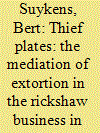| Srl | Item |
| 1 |
ID:
098351


|
|
|
|
|
| Publication |
2010.
|
| Summary/Abstract |
This study examined the correlates of distance to crime in a sample of 412 prison inmates in the Mexico City Metropolitan Area. The study focused on crimes of theft and included a spatial analysis of the crime scene and the place of residence of the prison inmates. The data show a high clustering of criminals in a few neighbourhoods surrounding the old downtown area. Also, 38.8% of the sampled criminals committed their crimes in the same neighbourhood where they lived. Regression analysis revealed two independent and positive correlations of distance to crime: the monetary gain of the crime and if the prison inmates' intimate partner was also in jail. These findings suggest that, aside from the monetary rationale in the distance to crime function, the neighbourhood and family contexts deserve further research for a better understanding of criminal behaviour in Mexico.
|
|
|
|
|
|
|
|
|
|
|
|
|
|
|
|
| 2 |
ID:
080634


|
|
|
|
|
| Publication |
2008.
|
| Summary/Abstract |
The ancient Aztecs created the largest empire in the prehistory of Mesoamerica. During this brief period (1428-1521 AD), Aztec life was complex and volatile. This article treats the place of crime and deviance within this dynamic setting, exploring (1) the Aztec historical and institutional context for living a proper (and improper) life, (2) recorded and expected realms of criminal and deviant behaviour, (3) opportunities for malfeasance and those who took advantage of them and (4) the manner in which Aztec institutions and powerful individuals dealt with crime and deviance. These dimensions provide the basis for an explanatory discussion of the presence or absence of organised crime in Aztec life
|
|
|
|
|
|
|
|
|
|
|
|
|
|
|
|
| 3 |
ID:
190161


|
|
|
|
|
| Summary/Abstract |
Around half a million rickshaws ply the streets of Dhaka, Bangladesh. To deal with the problem of theft, owner associations started to issue ‘thief plates’. These allow owners to get their rickshaws back at a reduced price. They also offer a protection against theft. This article argues that these plates form material mediators brokering relations between rickshaw owners and drivers, and thieves. Building on the literature on state-citizen brokerage, bureaucratic materialities and Anton Blok’s work on mafia, it wants to highlight the centrality of mediation in understanding practices of protection/extortion. It also aims to contribute to the literature on mafia in South Asia, showing the need to pay attention to norms of non-violence when dealing with violent or criminal strongmen.
|
|
|
|
|
|
|
|
|
|
|
|
|
|
|
|